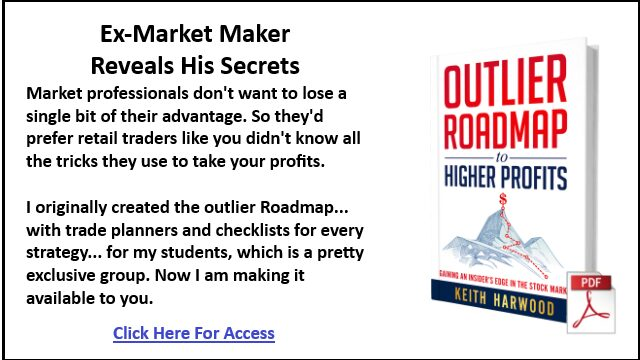by Oliver Velez
The Entry
First let’s talk more about the entry. We know the entry will be made above the prior bar’s high once our setup is in place. This is the standard entry. There is a circumstance that can occur where we can use an alternate entry, if you have the capability of being with a market in the morning. If you are trading remotely, this may not be a choice. This circumstance occurs when the last bar down is a very wide bar. The problem is that entry over this bar will cause the stop loss to be very far away. It may be far enough away that you no longer desire to take the trade. If this is the case, we can substitute a 30 minute high entry on the current day rather than waiting to trade over the prior day’s high. This means that you let the stock trade for 30 minutes, mark off a high of the day at that time, and buy the stock when it trades over that 30 minute high. You will be getting in before the prior days high in this case, so the failure rate will be higher when you opt for this technique. The advantage is that your stop will be much smaller and in some cases, it may be the only option other than passing the trade.
In some cases, a 30-minute high of the current day can be used to enter the stock.
While we’re talking about entries, let’s discuss what to do if the stock actually opens above the prior day’s high. This is called gapping up. It means that the stock opens the trading day at a price higher than it closed the prior day. This can happen because of news that affects the market in general or news about the specific stock. When this happens, you need to make a decision about whether the gap is excessive or not. As a guideline I like to say that a gap of 50 cents or more for the average $30 stock is excessive. Anything less than that is not. If there is a gap up that is not excessive, you may simply buy the stock because it has now triggered above the prior day’s high. If the gap is excessive, you use the thirty-minute buy rule. This means that we let the stock trade for 30 minutes and only buy if it is strong enough to take out its 30 minute high.

The reason for this rule is that stocks may gap up excessively only to trade down the rest of the day. There is no point in entering a stock when it stays weak all day.
If the stock gaps up excessively, use the 30-minute buy rule to be safe.
The Stop Loss
Next let’s talk about stop losses. A protective stop loss is known as an insurance policy because it protects against the catastrophic loss of hanging on to a losing trade with no action plan in place. A trade should never be entered without knowing 1) where the stop loss is and 2) making sure that the trade is exited if the stop loss is hit. For the buy setup, we will always be placing the stop underneath the entry bar or the prior bar, whichever is lower.
Some traders will add a few pennies to the entry price and subtract a few pennies from the stop loss price to avoid “false triggers” where the stock trades above or below the number you are watching but never follows through.
You see, every market player needs to draw a line in the sand. You need to mark off a point at which you are not willing to go beyond. The ostrich approach in the market does not work. We need to draw a line that says if the stock does not perform, and it hits this line, it gets eliminated. Every single stock I buy, I look at as my employee. It either has to perform or it gets fired. And that line is basically telling the stock “You touch this line, and you’re out of my life” and you move on to the next trade.
I need to stop here and comment for a moment on the use of protective stop losses. It is a fact that the vast majority of traders who fail to generate profits trading, whether they be long-term or short-term, do so because of the failure to follow stop losses. Now I just gave you the formula for where to place a protective stop loss. It goes under the current entry bar or the prior bar, whichever bar is lower. That is not difficult to understand. So you need to realize that the traders who do not follow stop losses do not do so because they cannot figure out where to place a stop loss. There are psychological demons that set into virtually everybody when they trade, and these demons often prohibit people from actually stopping the trade even though they know exactly where to stop it.
Here is a situation where you may use an altered stop. If the distance to the low of the prior bar is so wide that once again the stop becomes prohibitively large, you may opt to use the current days low even though it is not the lower of the two.
The Target
Now let’s take a look at the target. If you have noticed, we have determined an entry and stop loss price that will literally be to the penny. Targets are a little trickier, however. We know that if we are in an uptrend, we can expect to meet or exceed the prior high. Therefore, this will always be our first goal for a target area. The problem is that in strong uptrends, many times the stock may go far beyond that prior high.
The distance from my entry price to my target, compared to the distance from my entry price to the stop, is known as the reward to risk ratio. Many traders set up a minimum reward to risk ratio before taking a trade.
It is not very satisfying to be out of a trade while it runs several times beyond your intended target.
Taking targets is one of my worst demons. For a long time I was always too quick to take profits only to see a large chunk of the trade sit on the table as the stock rallied without me. That is why I’ve become a firm believer in incremental target taking. What that means quite simply is setting multiple targets in the general areas the stock may be likely to run and manage them on the way up. This allows me to “take home some bacon today” while still leaving some of the trade on for the big move.
Another idea I like to use is to trail stop the last part of a trade. This will become clearer as I discuss management in the next paragraph; but the idea is to let part of the trade continue to rally for as long as the stock does.
Managing The Trade
Finally we need to discuss the management of the trade. This is pretty straightforward, but there are a couple of options that are available. When I first enter the trade, I have my initial stop loss in place. This is where I will exit the stock if it does not move in my favor. I will keep this stop in place for the first two days; meaning, the day that I enter the stock as well as day two. Then on day three I will raise that stop to the low of day two. On day four the stop will become the low of day three, and so on. This is known as a “bar by bar” trail stop because every prior bar’s low becomes your new stop. Note that this policy does not begin until day three. For the first two days of the trade, the original stop is used.
I use the original stop for two days initially because sometimes the trade may be slow to get moving. Here is where another option may come into play. Everyone has a different level of patience and tolerance and this may affect how you wish to manage some of the finer points of these trades. If you like to give the stock a little more room while adhering to the original stop, you may want to consider keeping the original stop in place beyond the recommended two days. Wait until the stock price travels more than halfway to the first target before you begin a bar by bar trail stop management policy. Sometimes getting the stop too tight, too early in the trade, is not beneficial. Give the stock some room to get going and once it shows that it is moving up, then use the bar by bar trail stop.










Recent Comments